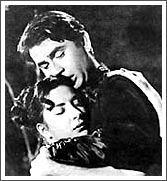
HOME | MOVIES | FEEDBACK |

Dinesh Raheja
At the ongoing Cannes Film Festival, three of actor-filmmaker Raj Kapoor's films are being screened --- Aag, Barsaat and Awaara.
Barsaat is flush with a heady, impassioned romanticism and lined with melancholy. This musical was Raj Kapoor's first directorial hit; the filmmaker came a full circle with his last Ram Teri Ganga Maili --- both stories about rustic innocence sullied by, and suffering because of contact with the outside world.
In Barsaat, two diametrically different cityslickers Pran (Raj
Kapoor) and Gopal (Premnath) enjoy their affluence by driving a huge foreign car down to the mountains. Amidst the lush natural beauty (evocatively captured in the song Hawa mein udta jaaye sung by a mountain maid), they ponder over love.
Premnath plays a blank-souled hedonist, who leaves a trail of seductions behind him. Raj plays a sensitive soul who sticks to his kisika dil na dukhana philosophy.
The caddish Premnath had made loads of promises to Neela (Nimmi, in her debut film) the previous year; the innocent mountain lass is still awaiting his return. Premnath makes fresh avowals of love to her and promises to return with the barsaat. Of course, he has no intention of living up to his promises. When Nimmi sings the plaintive Barsaat mein hamse mile tum at their parting, he callously tosses peanuts and chomps on them.
As the friends continue their trip, Raj saves an attractive young girl from drowning. He falls in love with this rustic beauty, Ratna (Nargis). In one of the most identifiable sequences of the Hindi screen, an emotional Raj plays a melancholy tune on his violin
and Nargis rushes to him, as though pulled by a magnetic force --- the call of the violin becomes emblematic of their love.
A music instrument played an integral part in later love stories too --- the flute in Hero or the mandolin in Dilwale Dulhania Le Jayenge..
Both of Barsaat's love stories have a chequered destiny. Nargis'
father refuses to believe that a pardesi can have honourable intentions and Nargis, desperate to meet Raj, jumps into a raging river with only a rope tied to the shore. In a harrowing scene, her father cuts the rope and she is swept away.
Raj believes Nargis is dead and resists all of Premnath's chummy efforts to cheer him up. Nargis, meanwhile, has been saved by a simple-minded lout (K N Singh in an amusing characterisation), who fetches the village vaid for her by the simple expedient of carrying him over his shoulders.
His plans to forcefully marry her are foiled when Raj's car crashes near the wedding site. Premnath is touched by Nargis' staunch belief that her lover will survive the crash; just as he was by the survival of Raj's love for Nargis even after her 'death'. Love finally melts his heart and he decides to do the honourable thing with the perenially-in-waiting Nimmi.
Ironically, just when all is well, Nimmi misreads his relationship with his bhabhi Nargis and commmits suicide. The rain clouds have chosen to cosmically bless just one of the love pairs.
The redemptive power of love and Premnath's transformation is well-graphed and not overnight. He goes from saying Mujhse kisiki zaroorat nahin to seeing the depth of Raj's love and sighing, Mera bhi tumhari tarah tadapne ko jee karta hai.
Barsaat is also more than just a simplistic conflict between the two types of the human psyche as represented by the two friends. It posits that it could be part of the same man. As Raj tells Premnath: "Insaan ke andar hamesha do shakshiyat ek doosre se bilkul doosri disha mein kaam karti hai. Kabhi kabhie main tumhe dekhkar sochta hoon tum mera hi hissa ho." The director has externalised this conflict by splitting it over two people.
On the flip side, there's excessive verbosity, flowery pontifications on love and the slow-paced film can get
maudlin.
Jal Mistry's elaborate framing of shots and the performances lift your spirits. Premnath is perfectly cast and has a scruffy charm. Despite Nargis' presence, Nimmi gets to lip sync to such hits as Jeeya bekarar hai and Barsaat mein. She makes an arresting debut.
The palpable Raj-Nargis chemistry is the raison d'etre of the film. They had already starred in another blockbuster Andaaz earlier the same year, and with Barsaat became an eternal pair in the minds of cinegoers.
Sidelights:
*Barsaat made several careers. It was the first hit for Raj Kapoor's banner which established the core team of RK-Nargis-Shanker-Jaikishan-Hasrat-Shailendra. It was after Barsaat's thumping success that Raj Kapoor had the money to buy RK studios in 1950.
*The scene from Barsaat where Raj Kapoor holds Nargis in one hand and the violin in the other became the RK embelem.
*It was Premnath's first success and he became a leading man who romanced heroines like Meena Kumari, Madhubala and Vyjayanthimala before turning towards villainy in the 60s.
*The story and dialogue writer Ramanand Sagar went onto become a famous independant director.
The Music:
*New music directors Shanker-Jaikishan scored a perfect ten in this film. Fifty-two years later, the film's soft melodies and the famed Tak dhina dhin refrain in Barsaat mein still fall as easily on the ears as the first rains of the season.
*Fresh from her Andaz triumph, Lata established herself with Barsaat, giving vocals for both Nargis and Nimmi.
*While Hasrat wrote most of the songs, including the captivating imagery in Hawa mein udta jaaye, Kapoor cajoled poet Shailendra into making his debut as a lyricist by offering him Rs 500 for Barsaat mein and Patli kamar.
You might also want to read:
|
||
© 1996 - 2002 rediff.com India Limited. All Rights Reserved. |
|||